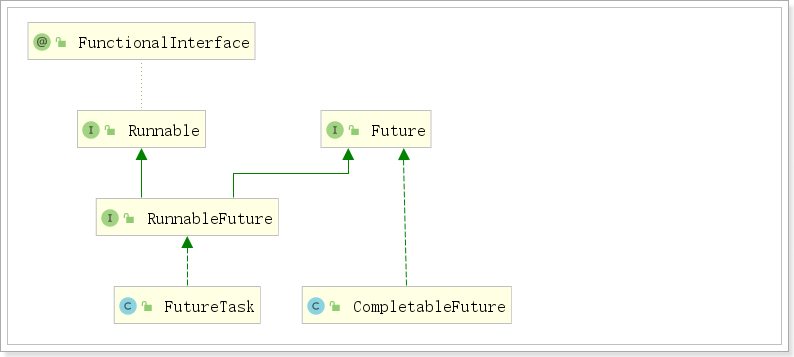CompletableFuture异步调用
问题:查询商品详情页的逻辑非常复杂,数据的获取都需要远程调用,必然需要花费更多的时间。
假如商品详情页的每个查询,需要如下标注的时间才能完成
// 1. 获取sku的基本信息 0.5s
// 2. 获取sku的图片信息 0.5s
// 3. 获取sku的促销信息 TODO 1s
// 4. 获取spu的所有销售属性 1s
// 5. 获取规格参数组及组下的规格参数 TODO 1.5s
// 6. spu详情 TODO 1s
.........
那么,用户需要6.5s后才能看到商品详情页的内容。很显然是不能接受的。
如果有多个线程同时完成这6步操作,也许只需要1.5s即可完成响应。
1. 线程回顾
初始化线程的4种方式:
- 继承Thread
- 实现Runnable接口
- 实现Callable接口 + FutureTask (可以拿到返回结果,可以处理异常)
- 线程池
方式1和方式2:主进程无法获取线程的运算结果。不适合当前场景
方式3:主进程可以获取线程的运算结果,并设置给itemVO,但是不利于控制服务器中的线程资源。可以导致服务器资源耗尽。
方式4:通过如下两种方式初始化线程池:
Executors.newFiexedThreadPool(3);
//或者
new ThreadPoolExecutor(corePoolSize, maximumPoolSize, keepAliveTime, TimeUnit unit, workQueue, threadFactory, handler);
通过线程池性能稳定,也可以获取执行结果,并捕获异常。但是,在业务复杂情况下,一个异步调用可能会依赖于另一个异步调用的执行结果。
2. CompletableFuture介绍
Future是Java 5添加的类,用来描述一个异步计算的结果。你可以使用isDone方法检查计算是否完成,或者使用get阻塞住调用线程,直到计算完成返回结果,你也可以使用cancel方法停止任务的执行。
虽然Future以及相关使用方法提供了异步执行任务的能力,但是对于结果的获取却是很不方便,只能通过阻塞或者轮询的方式得到任务的结果。阻塞的方式显然和我们的异步编程的初衷相违背,轮询的方式又会耗费无谓的CPU资源,而且也不能及时地得到计算结果,为什么不能用观察者设计模式当计算结果完成及时通知监听者呢?
很多语言,比如Node.js,采用回调的方式实现异步编程。Java的一些框架,比如Netty,自己扩展了Java的 Future接口,提供了addListener等多个扩展方法;Google guava也提供了通用的扩展Future;Scala也提供了简单易用且功能强大的Future/Promise异步编程模式。
作为正统的Java类库,是不是应该做点什么,加强一下自身库的功能呢?
在Java 8中, 新增加了一个包含50个方法左右的类: CompletableFuture,提供了非常强大的Future的扩展功能,可以帮助我们简化异步编程的复杂性,提供了函数式编程的能力,可以通过回调的方式处理计算结果,并且提供了转换和组合CompletableFuture的方法。
CompletableFuture类实现了Future接口,所以你还是可以像以前一样通过get方法阻塞或者轮询的方式获得结果,但是这种方式不推荐使用。
CompletableFuture和FutureTask同属于Future接口的实现类,都可以获取线程的执行结果。

3. 创建异步对象
CompletableFuture 提供了四个静态方法来创建一个异步操作。
static CompletableFuture<Void> runAsync(Runnable runnable)
public static CompletableFuture<Void> runAsync(Runnable runnable, Executor executor)
public static <U> CompletableFuture<U> supplyAsync(Supplier<U> supplier)
public static <U> CompletableFuture<U> supplyAsync(Supplier<U> supplier, Executor executor)
没有指定Executor的方法会使用ForkJoinPool.commonPool() 作为它的线程池执行异步代码。如果指定线程池,则使用指定的线程池运行。以下所有的方法都类同。
- runAsync方法不支持返回值。
- supplyAsync可以支持返回值。
4. 计算完成时回调方法
当CompletableFuture的计算结果完成,或者抛出异常的时候,可以执行特定的Action。主要是下面的方法:
public CompletableFuture<T> whenComplete(BiConsumer<? super T,? super Throwable> action);
public CompletableFuture<T> whenCompleteAsync(BiConsumer<? super T,? super Throwable> action);
public CompletableFuture<T> whenCompleteAsync(BiConsumer<? super T,? super Throwable> action, Executor executor);
public CompletableFuture<T> exceptionally(Function<Throwable,? extends T> fn);
whenComplete可以处理正常和异常的计算结果,exceptionally处理异常情况。BiConsumer<? super T,? super Throwable>可以定义处理业务
whenComplete 和 whenCompleteAsync 的区别:
whenComplete:是执行当前任务的线程执行继续执行 whenComplete 的任务。
whenCompleteAsync:是执行把 whenCompleteAsync 这个任务继续提交给线程池来进行执行。
方法不以Async结尾,意味着Action使用相同的线程执行,而Async可能会使用其他线程执行(如果是使用相同的线程池,也可能会被同一个线程选中执行),即同步和异步的区别
代码示例:
public class CompletableFutureDemo {
public static void main(String[] args) throws ExecutionException, InterruptedException {
CompletableFuture future = CompletableFuture.supplyAsync(new Supplier<Object>() {
@Override
public Object get() {
System.out.println(Thread.currentThread().getName() + "\t completableFuture");
int i = 10 / 0;
return 1024;
}
}).whenComplete(new BiConsumer<Object, Throwable>() {
@Override
public void accept(Object o, Throwable throwable) {
System.out.println("-------o=" + o.toString());
System.out.println("-------throwable=" + throwable);
}
}).exceptionally(new Function<Throwable, Object>() {
@Override
public Object apply(Throwable throwable) {
System.out.println("throwable=" + throwable);
return 6666;
}
});
System.out.println(future.get());
}
}
5. 线程串行化方法
thenApply 方法:当一个线程依赖另一个线程时,获取上一个任务返回的结果,并返回当前任务的返回值。
thenAccept方法:消费处理结果。接收任务的处理结果,并消费处理,无返回结果。
thenRun方法:只要上面的任务执行完成,就开始执行thenRun,只是处理完任务后,执行 thenRun的后续操作
带有Async默认是异步执行的。这里所谓的异步指的是不在当前线程内执行。
public <U> CompletableFuture<U> thenApply(Function<? super T,? extends U> fn)
public <U> CompletableFuture<U> thenApplyAsync(Function<? super T,? extends U> fn)
public <U> CompletableFuture<U> thenApplyAsync(Function<? super T,? extends U> fn, Executor executor)
public CompletionStage<Void> thenAccept(Consumer<? super T> action);
public CompletionStage<Void> thenAcceptAsync(Consumer<? super T> action);
public CompletionStage<Void> thenAcceptAsync(Consumer<? super T> action,Executor executor);
public CompletionStage<Void> thenRun(Runnable action);
public CompletionStage<Void> thenRunAsync(Runnable action);
public CompletionStage<Void> thenRunAsync(Runnable action,Executor executor);
Function<? super T,? extends U>
T:上一个任务返回结果的类型
U:当前任务的返回值类型
代码演示:
public static void main(String[] args) throws ExecutionException, InterruptedException {
CompletableFuture<Integer> future = CompletableFuture.supplyAsync(new Supplier<Integer>() {
@Override
public Integer get() {
System.out.println(Thread.currentThread().getName() + "\t completableFuture");
//int i = 10 / 0;
return 1024;
}
}).thenApply(new Function<Integer, Integer>() {
@Override
public Integer apply(Integer o) {
System.out.println("thenApply方法,上次返回结果:" + o);
return o * 2;
}
}).whenComplete(new BiConsumer<Integer, Throwable>() {
@Override
public void accept(Integer o, Throwable throwable) {
System.out.println("-------o=" + o);
System.out.println("-------throwable=" + throwable);
}
}).exceptionally(new Function<Throwable, Integer>() {
@Override
public Integer apply(Throwable throwable) {
System.out.println("throwable=" + throwable);
return 6666;
}
});
System.out.println(future.get());
}
6. 多任务组合
public static CompletableFuture<Void> allOf(CompletableFuture<?>... cfs);
public static CompletableFuture<Object> anyOf(CompletableFuture<?>... cfs);
allOf:等待所有任务完成
anyOf:只要有一个任务完成
public static void main(String[] args) {
List<CompletableFuture> futures = Arrays.asList(CompletableFuture.completedFuture("hello"),
CompletableFuture.completedFuture(" world!"),
CompletableFuture.completedFuture(" hello"),
CompletableFuture.completedFuture("java!"));
final CompletableFuture<Void> allCompleted = CompletableFuture.allOf(futures.toArray(new CompletableFuture[]{}));
allCompleted.thenRun(() -> {
futures.stream().forEach(future -> {
try {
System.out.println("get future at:"+System.currentTimeMillis()+", result:"+future.get());
} catch (InterruptedException | ExecutionException e) {
e.printStackTrace();
}
});
});
}
测试结果:
get future at:1568892339473, result:hello
get future at:1568892339473, result: world!
get future at:1568892339473, result: hello
get future at:1568892339473, result:java!








 本文探讨了如何利用Java 8的CompletableFuture优化复杂的商品详情页查询,通过线程池和回调机制减少等待时间,实现高效并发。
本文探讨了如何利用Java 8的CompletableFuture优化复杂的商品详情页查询,通过线程池和回调机制减少等待时间,实现高效并发。
















 5104
5104

 被折叠的 条评论
为什么被折叠?
被折叠的 条评论
为什么被折叠?








